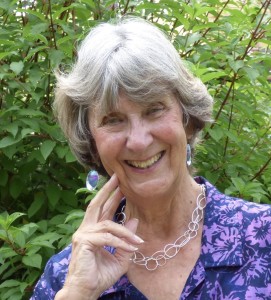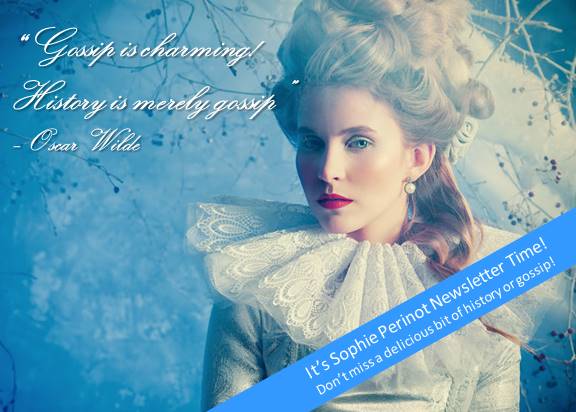Category: Get To Know the WRiters I Know
Interview with Laura Morelli, Author of THE GIANT
If you’ve been to Florence you’ve seen Michelangelo’s David. If you haven’t been to Florence you’ve seen countless images of him. The David is a cultural icon and even 500 years after his creation still has the power to leave us awe struck.

Now Laura Morelli—talented novelist and PhD Art Historian—has a breathtaking new novel out about the creation of this Renassaisance Art Masterwork, and I am THRILLED to welcome her to my blog today to talk about the process of creation for both her novel, THE GIANT, and Michelangelo’s David!
Let’s start things off with a teaser for THE GIANT . . . .
As a colossal statue takes shape in Renaissance Florence, the lives of a master sculptor and a struggling painter become stunningly intertwined.
Florence, 1500. Fresco painter Jacopo Torni longs to make his mark in the world. But while his peers enjoy prestigious commissions, his meager painting jobs are all earmarked to pay down gambling debts.
When Jacopo hears of a competition to create Florence’s greatest sculpture, he pins all his hopes on a collaboration with his boyhood companion, Michelangelo Buonarroti. But will the frustrated artist ever emerge from the shadow of his singularly gifted friend?
From the author of THE PAINTER’S APPRENTICE and THE GONDOLA MAKER comes a gorgeously crafted, immersive tale of Renaissance Italy.
Laura, I have such distinct memories of the first time I stood in front of Michelangelo’s David—gape-mouthed and totally in awe. What do you think draws people to the David?
Me too! I am always amazed at the number of people who tell me that this sculpture is the thing that impressed them the most on a trip to Italy.
In fact, when my family returned from Italy last summer, I asked my four teenagers to name the top three favorite things they saw. The David was on the top of each of their lists (and I promise I tried not to influence their choices!). I think that’s amazing.
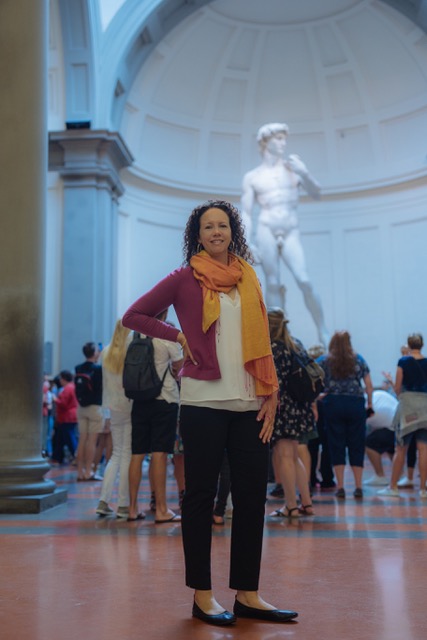
A Time Magazine article in the 1980s reported on the “emotional trauma” experienced by first-time viewers of the David. And a few visitors have even tried to disrobe before the statue, only to be quickly led away by museum guards!
I have long wondered what it was about this statue and the irreverent stone carver who made it that still has the power to capture people’s imagination–to make their jaws drop, to leave them speechless–even in our current time of multimedia overload. And even after studying it for some thirty years, I’m still not convinced it’s something that can be put 100% into words. That’s the power of art!
As a PhD art historian, how do you think the David influenced the course and direction of art at the moment of its unveiling and in the aftermath of its creation?
The David was the first colossal nude on Italian soil since ancient Roman times. Think about that… For a thousand years, no one had seen a nude male sculpture of this scale. But this David is actually a biblical hero in the guise of an ancient god, at the same time that he appears as a god in the image of a perfect man. He is both an Adam and a Hercules, both a Christian and a civic / political symbol. In short, the David seems to telescope all the aspirations and the ideals of the High Renaissance in a single work of art. I don’t think any sculptor who worked in Europe after 1504 could ignore it. Later works, like those of Gianlorenzo Bernini, would have been unimaginable without Michelangelo’s precedent.
Sometimes truth really is stranger than fiction. Can you share a fact or scene from The Giant which actually happened (or existed), but seems too strange to be true?
We have an amazing contemporary account of the sculpture leaving the cathedral workyard, where Michelangelo had been working on it for four years. At midnight on May 4, 1504, laborers broke the stone lintel above the gate of the workyard and began to move the sculpture slowly toward the Piazza della Signoria. They suspended the sculpture from a contraption made of ropes and pulleys, as well as greased logs to roll it forward. It took several days to reach its intended location. During that time, some boys were arrested for throwing stones at it; one of them turned out to be a relative of Lisa Gherardini—yes, the Mona Lisa (whose portrait Leonardo da Vinci was painting at the time, just a few streets away). You can’t make this stuff up!
Of course Michelangelo is not the only artist in The Giant . . . can you tell us a little bit about Jacopo Torni (or the artist he is based upon) and why you felt his story needed to be told?
As I looked for the right person to tell the story of Michelangelo’s gigante, I came across historical references to a Florentine fresco painter called Jacopo Torni, also known as L’Indaco.
The sixteenth-century art historian Giorgio Vasari tells us that L’Indaco lived “in close intimacy” with Michelangelo, and that Michelangelo found L’Indaco the funniest and most entertaining of his friends. We also know that Michelangelo invited L’Indaco to work with him on the Sistine Chapel in 1508. According to some sources, it was a friend who convinced Michelangelo to return to Florence to take on the David commission in 1501, and I like to think it was L’Indaco.
Michelangelo is one of the most notoriously temperamental artists in history, and I wondered about this relationship of seeming opposites. It is this push and pull of two creative friends, in combination with the creation of two of the most seminal works of art history—the David and the Sistine Chapel ceiling—that drew me to this story and made me want to explore this complicated friendship further.
Finally, I’d like to close out things with a Rapid Fire round:
- Favorite Italian dish: Risotto alla milanese, without a doubt!
- Character you’d love to write about but probably never will: A living artist.
- Why won’t you? It would be so tricky, I think, to write fiction or nonfiction about a real person who is either living or recently deceased.
- A piece of art that is special to you other than the David: I saw the cathedral of Notre Dame in Paris when I was 12 years old, and it was a “coup de foudre.” It led me to want to pursue art history and it’s still such a special building to me.
- Do you write to music or in silence? I love peace and quiet when I write.

Thanks so much to Laura for stopping by! Don’t forget to pick up your copy of THE GIANT readers—at Amazon, Indiebound, on Bookshop.org to support Independent booksellers, or your favorite local bookstore!
INTERVIEW: Anne Easter Smith Dishes on Her Upcoming Novel About Richard III
Today, while on a short break from the mega-tour for my own latest novel Ribbons of Scarlet, it is my very great pleasure to host my good friend the insanely talented, multi-published, Anne Easter Smith in a Q&A to talk about her upcoming novel: This Son of York (releasing November 10th but you can pre-order now HERE).
This Son of York concludes Anne’s best-selling Wars of the Roses series. She’s made the much maligned Richard III, who was brought into new focus following the discovery of his bones under a car park in Leicester in 2013, her protagonist and is determined to give us a very different view of Richard than Shakespeare and stereotypes have . . .
Anne, people have very strong opinions about Richard III despite the short time he was on the English throne. Writing about Richard is, in many ways, like walking out into a battlefield mid-conflict, so let me start right off by asking why a novel centering on Richard? What compelled you into this contentious territory?
I love a good battle! Especially one with horses, armored knights, and longbows. But as far as Richard is concerned, he became a cause for me once I took in the Josephine Tey theory that those adorable princes in the Tower weren’t murdered by their hunchbacked uncle Richard but may have lived into the next reign. Horrible Henry Tudor (no, not that one with all the wives but his father) had far more to lose than Richard if indeed those little boys were still alive, because he had no right to the throne. But I digress.
Tey’s book Daughter of Time got me researching everything I could about Richard and the Wars of the Roses, and after five decades I feel quite knowledgeable enough to have written my version of Richard’s story. You may be surprised to know that faux news began a lot earlier than today! Shakespeare’s sources for his play were Tudor historians who spun the historical facts about Richard so well that we still believe them today (even though much new evidence has come out in the meantime, if not exonerating Richard of those many crimes laid at his door, at least raising plausible doubt.) Being a Brit, fair play is in my DNA, and Richard has been unjustly depicted through the centuries.
What is the pernicious misconception about Richard that you’d most like to correct in the minds of readers?
That he murdered his nephews in the Tower in order to “steal” the crown. No bodies have ever been found, no evidence they were even murdered, and no witnesses or confessions to the deaths have surfaced in all this time. From everything I have studied about Richard, he was never interested in wearing the crown. It was pushed on him by Parliament when the princes were revealed to have been illegitimate (their dad, Edward IV and Richard’s brother, had been secretly “contracted” to a woman prior to marrying their mum.)
Is there such a thing as a fun-fact when it comes to Richard III—and if so can you share one?
Hmmm, I don’t have him picking his teeth with his knife (that was a no-no even for the most ill-bred), but “fun” and Richard is a bit of an oxymoron. He was a naughty boy before he married Anne Neville (at 19), because we know he had two and possibly three bastards. He was very discreet about their mother(s), but two of them were brought up in his household and mentioned in letters and household accounts.
I know This Son of York has taken considerable time, research and thought on your part, can you offer us a little window into your process of creating the book?
After Royal Mistress was published in 2013—the fifth book in my series about the Yorks during the Wars of the Roses—I thought I was done with Richard and his family, and I started to write a wonderful story about a Portuguese prince and his mistress in 14th century. (It took me several years of research and three trips to Portugal to feel comfortable writing about this prince.) And then they found Richard’s grave under a car park in Leicester in 2012 and I was so excited and intrigued by the new information the bone analysis gave us of him that I dropped poor Pedro into the Tagus River and took up Richard’s cause again. After all, I had every date and event and character I needed to write about still stuck in my brain, but with new info on Richard—like severe scoliosis and that he drank heavily in the last two years of his life—I was moved to return to Richard and write his story for a new century.
My process is mostly being as organized as possible. I have charts of timelines where I make sure no real person is in the wrong place at the wrong time, unless it’s unclear and then I can fictionalize meetings or scenes. But I don’t mess with history.
Thank you so much for taking the time to stop by the blog and begin to set the record straight on Richard, Anne!
Thank you so much for hosting me here, Sophie. I am so passionate about readers knowing more about Richard than Shakespeare’s “bunch-backed toad” and I think I am giving them a more balanced view of this much-maligned king. He only lived to be thirty-two, and only reigned for two years, but his whole life was devoted to being loyal to his family, his king, his wife, and if I get just one person to change their opinion of him by doing the research I did, I will be satisfied! I promise you, his is quite the dramatic story!
Finally for those who want to purchase This Son of York—and after reading Anne’s answers I am betting that is everyone—remember if is available for pre-order on Amazon! Below I’ve included a description of the novel, and some of the praise it is already garnering!
Praise for This Son of York . . .
Anne Easter Smith has written five well-regarded novels set in the War of the Roses, but the one she has been preparing to write, both in her imagination and after fifty years of research, is this novel about Richard III. Her mission was to bring Richard Plantagenet the man to life and let him speak directly to us in this meticulously rendered novel.
—Margaret George, International best-selling author of Elizabeth I and The Confessions of Young Nero
Deeply researched, the book bursts with action but even more importantly we are given passages of real feeling between human beings we think we may know but perhaps never completely understood until this book. It is a moving, insightful, and engrossing depiction of the controversial king.”
—Nancy Bilyeau, best-selling author of The Blue
A wonderfully realized life of tragic, doomed Richard. The author uses the latest discoveries and old texts to fully explore the complicated ‘crouchback’, and give us a fine portrait of the lover and the warrior, a noble, flawed and heroic king and man.”
—C. C. Humphreys, author of Vlad: The Last Confession
THIS SON OF YORK
Concluding her best-selling Wars of the Roses series, Anne Easter Smith has made Richard III her protagonist in her latest book This Son of York. The much maligned Richard is brought into new focus following the discovery of his bones under a car park in Leicester. 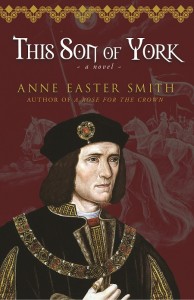
As the fourth son of the duke of York, Richard of Gloucester could not have hoped for much more than the life of a wealthy, but insignificant nobleman. Instead fate took him down a drama-filled, unexpected path to the throne. As York challenged Lancaster for the crown, early tragedies and betrayals, including by his faithless brother George, led the young Richard to count on none but himself. Imbued with the traits of loyalty and duty to family and country, he proved them time and again especially when he reluctantly came to wear the crown. Buoyed by the love of two women, he stayed true to one while cherishing the other, both helping him bear the burden of his scoliosis.
A warrior of renown, a loyal brother, loving husband and father, a king mindful of injustice yet beset by betrayal, and a man convinced his God has forsaken him by burdening him with crippling scoliosis, This Son of York has a compelling tale to tell. With her meticulous attention to detail—and the truth—Easter Smith’s compelling storytelling paints a very different picture of the king Shakespeare reviled as “…thou elvish-marked, abortive, rooting hog.”
Extra, Extra, Read All About It!
Did you know Dear Readers that I have an awesome newsletter? My 2017 newsletter is ALL about feeding readers’ cravings for more delicious gossip—I mean HISTORY (see the Oscar Wilde quote below)! It will come out monthly, and each month will have its own theme. One FANTASTIC new feature–the Mini-view–will appear in every issue. Each Mini-view asks 3 top historical novelists a single question and brings you their answers.
The latest issue is just out! It’s all about DANGEROUS WOMEN (Catherine de Médicis anyone?). So if you are already a subscriber check your inbox. And if you aren’t . . . never fear, it is not too late! Click here and fill out the form! The newsletter will be in your box in a jiffy.
Marguerite de Valois: Shinning a Light on a Much Maligned French Princess
Light is a frequent literary device. It can be an emblem of hope, a way to see what has been hidden, even a method of symbolically driving back demons. This month a collection of historical novelists, including myself, have decided to use light in all those ways, by creating a weekly blog event (#LightOnOurLadies) to illuminate the historical women at the center of our writings. The main character in my next novel, Médicis Daughter, is profoundly in need of such illumination. 
History has not been kind to 16th century French Princess Marguerite de Valois. In fact, she has been quite viciously misremembered as a wanton and a woman without substance. Before I explain how I think that happened, please allow me to shine a little light on the real Marguerite.
Born at the Château of Saint-Germain overlooking the Seine, as her father had been before her, Marguerite (or Margot as she was affectionately called) was the eighth child of King Henri II of France and Queen Catherine de Médicis. Described by the poet Ronsard as tall and graceful, with fine pale skin, sparkling black eyes, and chestnut hair, Margot stood out even at a Court renowned for its beauties. But she had more than looks going for her—far more. A true granddaughter of François I, Margot was highly intelligent. She loved books, and often got so swept away by them that she forgot to eat or sleep (sound familiar to anyone reading this?). As a mature woman, Margot was a serious and influential force in the literary life of France. A student of more than literature, Margot was a solid classics scholar. She spoke multiple languages fluently, and also had a genuine talent for public speaking. This she was frequently asked to do, often representing one royal brother or another. Finally Margot had a keen grasp of the fine points of statecraft. Arguably her political acumen exceeded that of her brothers, making her the most similar of all her siblings to her strong-willed, politically expert mother, Catherine de Médicis.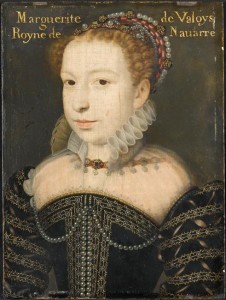
Why then, if Margot was as competent as she was pretty is she so little remembered? And when recalled, why is Margot depicted not as she was, but as lascivious and nearly amoral?
To put it simply, Marguerite de Valois was a victim of poor timing. She was born at the end of her dynasty.
When a royal house expires, its last years are generally recounted by people who have political and personal agendas that make it tempting to denigrate their predecessors. Such was the fate of Valois in the late 16th Century. Slander and denigration of royal family began during their lifetimes, largely fed by the tensions and rivalries of a vicious series of wars (the French Wars of Religion) that stretched from the early 1560s beyond the end of the Valois reign. No member of the Valois was exempt from the attacks of gossips, or from the writings of anonymous political pamphleteers. Anti-Valois propagandists seeking to degrade Marguerite chose that easiest and most ancient path for destroying a woman: assertions of rabid sexual desire and wanton conduct.
Slanderous talk about Margot began early among her family’s enemies, but she owes most of the lasting defamation of her character to a single printed work, Le divorce Satyrique. This malicious pamphlet was composed in her lifetime. It mocked and insulted Margot as it set out grounds for a proposed annulment of her marriage to Henri de Bourbon. Margot’s cousin/husband was no longer merely King of the Navarre, but King Henri IV of France—and a king in need of an heir. We all know that a King in need of an heir will do what it takes to be rid of a queen who cannot give him one. So, grounds for an annulment were created and printed. That such a piece of propaganda should have been taken up as fact and treated as history for so long may seem astounding to us today, but early chroniclers of the French court were often not particularly concerned with objectivity. Nor were early historians. As Robert Ja Sealy remarks in The Myth of the Reine Margot, “the documentary sources for our knowledge. . . were written during the wars of religion and, all too frequently are colored by political expediency . . .” Objectivity as a goal rather than a veneer is a rather recent requirement for history and historians. Even some of the histories written in the 19th and early 20th centuries make no pretense at objectivity in recounting the period of the Wars of Religion. Rather, their authors unabashedly announce in their prefaces which side they are on. Margot, considered not a particularly important historical player, remained largely unexamined. The myths about her grew and thrived in darkness.
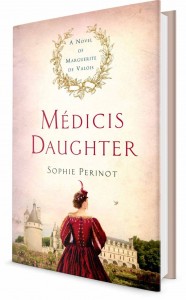 In Médicis Daughter I’ve focused a strong and clear light on the historical Marguerite, creating a coming-of-age story that does her better justice than she received from Valois disparagers, or from those later historians who saw no reason to look more closely. Médicis Daughter releases six weeks from today. To learn more about the book, visit the novel’s page at Amazon, or on Facebook.
In Médicis Daughter I’ve focused a strong and clear light on the historical Marguerite, creating a coming-of-age story that does her better justice than she received from Valois disparagers, or from those later historians who saw no reason to look more closely. Médicis Daughter releases six weeks from today. To learn more about the book, visit the novel’s page at Amazon, or on Facebook.
And now,
As part of the Shining Light on Our Ladies Tour, please meet my fellow authors Helen Hollick and Alison Morton… and their ladies
 Alison Morton is a woman after my own heart.
Alison Morton is a woman after my own heart.
Raised by a feminist mother and an ex-military father, it never occurred to Alison Morton that women couldn’t serve their country in the armed forces. After six years, she left as a captain, having done all sorts of interesting and exciting things she can’t talk about, even now…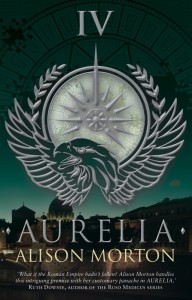
Fascinated by the complex, power and value-driven Roman civilisation since childhood, she wondered what a modern Roman society would be like if run by strong women…
Alison lives in France and writes award-winning Roman-themed alternate history thrillers with tough Praetorian heroines – INCEPTIO, PERFIDITAS, SUCCESSIO and now
… AURELIA: Late in 1960s, Aurelia is sent to Berlin to investigate silver smuggling, former Praetorian Aurelia Mitela barely escapes a near-lethal trap. Her old enemy is at the heart of all her troubles and she pursues him back home to Roma Nova but he has struck at her most vulnerable point her young daughter. Please visit Alison (and Aurelia) to read more – and a chance to win a paperback copy of Aurelia
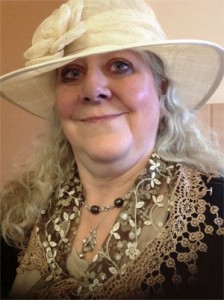 Helen Hollick is a fierce advocate for Indie Authors.
Helen Hollick is a fierce advocate for Indie Authors.
She lives on a thirteen-acre farm in Devon, England. Born in London, Helen wrote pony stories as a teenager, moved to science-fiction and fantasy, and then discovered historical fiction. Published for over twenty years with her Arthurian Trilogy, and the 1066 era, she became a ‘USA Today’ bestseller with Forever Queen. She also writes the Sea Witch Voyages, pirate-based fantasy adventures. As a supporter of Indie Authors she is Managing Editor for the Historical Novel Society Indie Reviews, and inaugurated the HNS Indie Award.
On her blog today Helen introduces some ladies from the Court of King Arthur, except this ‘court’ is set in 5th century Britain and her Gwenhwyfar, Morgause and Morgaine are very different from the ladies of the Medieval tales!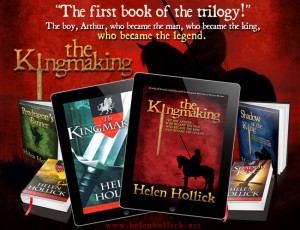
ENJOYING THE SHINING LIGHT ON OUR LADIES TOUR? Then please join us again NEXT TUESDAY when we set sail with Captain Jesamiah Acorne’s ladies aboard Sea Witch, meet a lady surgeon disguised as a man aboard another ship, and are introduced to lady blackmailed into marrying a knight….
Kate Quinn’s Second Borgia Book Is In Stores!
I’ve been so excited for publication of Kate Quinn’s “The Lion and the Rose,” which tells the story of the infamous Borgia family like you’ve never heard it before! And yesterday was “L” Day (that’s Launch Day for the uninitiated) at last. I am fortunate enough to be part of a launch-day triumvirate with Kate and Stephanie Dray–a troika of historical fiction writers dedicated to the premise that no author should be permitted to check her Amazon rankings on the day her book comes out and that a sumptuous lunch is the best preventative. So yesterday I was a lady-who-lunches rather than a lady who writes, abandoning myself to good company and good food and celebrating Kate and this new novel. So I guess I should show and tell a bit. Here’s the cover and the scoop:
Synopsis:
From the national bestselling author of The Serpent and the Pearl comes the continuing saga of the ruthless family that holds all of Rome in its grasp, and the three outsiders thrust into their twisted web of blood and deceit . . .
As the cherished concubine of the Borgia Pope Alexander VI, Giulia Farnese has Rome at her feet. But after narrowly escaping a sinister captor, she realizes that the danger she faces is far from over—and now, it threatens from within. The Holy City of Rome is still under Alexander’s thrall, but enemies of the Borgias are starting to circle. In need of trusted allies, Giulia turns to her sharp-tongued bodyguard, Leonello, and her fiery cook and confidante, Carmelina.
Caught in the deadly world of the Renaissance’s most notorious family, Giulia, Leonello, and Carmelina must decide if they will flee the dangerous dream of power. But as the shadows of murder and corruption rise through the Vatican, they must learn who to trust when every face wears a mask . . .
Some Review Quotes to Tempt you Further:
“Quinn creates memorable and authentic characters who embrace the aura of the era, and still speak to the modern reader’s sensibilitity. Beyond these remarkable people there are lush backdrops, fascinating historical details, and everything from espionage to murder, passion and piety. Quinn makes history accessible and unforgettable with her storytelling.” ~RT Book Reviews
“Beautifully written, and a topic that will open some eyes about the Borgias.” ~Romance Reviews Today
AND an Excerpt
“This is all terribly anticlimactic,” I complained to my mistress. “Captured by enemy forces, and where are the dungeons? The torturers? The chains? At the very least, you should have been sold into the harem of a Moorish merchant prince. That would be a story worth telling.” I hurt too badly to laugh at my own joke, so I gave a shallow sigh instead. “There is no literary scope in spending a few nights drinking French wine with French generals, listening to French compliments, then being escorted back to Rome in luxury.”
“I think it was a trifle more harrowing than that.” Giulia Farnese looked across the carriage at the bandages wrapping my chest and shoulder and hip, the splints a French surgeon had strapped to my broken fingers, the black bruises that covered nearly every visible inch of my flesh like splotches of pitch. “How is the pain, Leonello? And don’t just grit your teeth at me stoically, please.”
“Why, it’s a very splendid pain,” I said airily. “We’ve gotten to know each other very well, really—perhaps I shall give it a name and keep it for a pet when this is all over.” I had been beaten to a pulp by French pike-men, for daring to defend my mistress when French scouts descended like wolves on her traveling party as she made her way toward the Holy City. More precisely, I’d been beaten to a pulp because I’d killed three French pike-men and wounded two more before they brought me down, and such men do not like to be humiliated by a man like me.
I am a dwarf, you see. The kind you see in motley at fairs, juggling wooden balls, only I do not juggle and never have. I have the short bowed legs and the oversized head and the broad torso of my kind, but I also have uncommon skill at throwing knives. I can core a man’s throat like an apple at ten paces, and it was for that skill I was hired as bodyguard to Giulia Farnese, the Pope’s golden mistress. If she’d had a strapping youth for a guard, the French would have killed him at once—enemies fasten first on strapping youths when they look for those who might prove a threat. No one bothers to notice the dwarf.
Not until I kill them, and then it’s too late.
So if that has you itching to read more. Here are a couple of links where you can buy The Lion and the Rose.
FREE Books for Christmas!!!
Here’s an event that incorporates three of my favorite words – “free,” “books,” and “Christmas.” Author Genevieve Graham (Under the Same Sky & Sound of the Heart) has put together a marvelous two week celebration of books as holiday gifts—everyday a different author will be featured with an excerpt from her/his work and A BOOK TO WIN!!!
That’s TEN free books to be won. And on top of that, there are TWO triple-book grand prize packages on offer (entries for those opened today)!!! So that’s TWELVE chances to win (talk about the Twelve Days of Christmas!) Check out the author schedule below and check this link EVERYDAY for your chance to win another good book just in time for holiday gift-giving!
December 3rd — Joanna Bourne
December 4th — Pamela Callow
December 5th — MK McClintock
December 6th –Steve Vernon
December 7th – yours truly, Sophie Perinot
*** Weekend to do your shopping and wrapping (psst. . . buy books) ***
December 10th — Rona Altrows
December 11th — Kaki Warner
December 12th –Katherine S.Crawford
December 13th — Nya Rawlyns
December 14th Victoria Vane
PRIZE PACKAGES (entry period opened today): GRAND PRIZE #1 – Kaki Warner’s “Runaway Bride” series (3 books); GRAND PRIZE #2 – Pamela Callow’s “Kate Lange thriller series” (3 books)
Good luck all and never say I don’t share THE BEST giveaways and gift giving tips!
Countdown to Baltimore
Two more days. That’s ALL! On Friday the Baltimore Book Festival begins and I will be there—meeting and greeting readers in the Maryland Romance Writer’s tent at NOON on Friday (September 28th), then participating in four phenomenal panel discussions over Friday and Saturday. Will YOU be there too? I sure hope so! I will be keeping a sharp eye out and I hope—friends, fellow writers and readers—you will make yourself known with a big hello! Click here for a reminder of my schedule of appearances, festival hours, etc.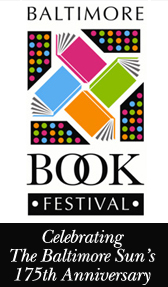
Interview with Erika Robuck Author of “Hemmingway’s Girl”
It is my very great pleasure to welcome fellow NAL author Erika Robuck to the blog today for the second in my “Get to Know the Authors I Know” series. Erika’s debut, Hemingway’s Girl released earlier this month.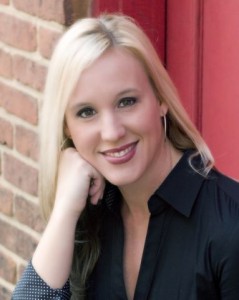
Set in Key West in 1935, Hemingway’s Girl centers on a young woman named Mariella Bennet who takes a job as a housekeeper for Ernest Hemingway and his second wife, Pauline, in order to support her widowed mother and to realize her own dream of starting a charter fishing boat business. Mariella quickly becomes entangled in the tumultuous world of the rich, their friends, and a marriage doomed for failure. Torn between her infatuation with the writer and relationships with a WW1 vet and a boxer, Mariella soon learns that she may be in over her head on all fronts.
1) Erika, Your book tells the story of Mariella Bennet, a fictional maid hired by Ernest Hemingway’s second wife. Is this book really her story or Papa’s?
Mariella is such a feisty, colorful character, that she stole the show about halfway through my first draft. She has a formidable opponent in Ernest Hemingway, but he never overshadows her.
2) Are you a big Hemingway fan yourself?
I am obsessed with Hemingway, and have been since I was nineteen years old and first read his work, just like my protagonist.
3) Where have you traveled for inspiration and research for Hemingway’s Girl?
My travels began in Key West at his house. I later flew up to Boston to the JFK Museum where 90% of the Hemingway archive is kept. I’m hoping my journey eventually takes me to his grave in Ketchum,Idaho.
4) Truth is often stranger than fiction. During your research for Hemingway’s Girl what was the most unusual or unexpected thing you discovered?
By far, the most unusual and disturbing story I found was of a Key West resident named Count Von Cosel, who faked being a doctor, fell in love with a tuberculosis patient decades his junior, and mourned her death so terribly that he exhumed her body and kept it in his house for years by rebuilding it with wax and preservatives. When the body was discovered, it was put on display for
several days so the residents of Key West could see it, before being returned to a secret grave in the cemetery where she was originally buried. The most bazaar detail about the story is that the residents of Key West thought that what he did was tragically romantic. The Count makes an appearance in Hemingway’s Girl.
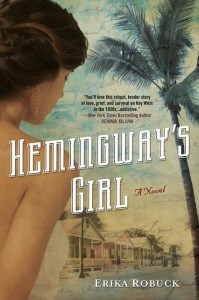 5) Who is your favorite character in Hemingway’s Girl? Who is your least favorite? Why?
5) Who is your favorite character in Hemingway’s Girl? Who is your least favorite? Why?
Wow, that’s a very hard question. My knee jerk response for my favorite was Hemingway, but then it became Mariella, and then Gavin the boxer, and then John the legless WWI veteran. I can’t pick because they are so vividly alive for me, and I love them all. If I had to pick my least favorite, it would have to be Hemingway’s second wife Pauline, who had an affair with Hemingway while he was married to his first wife, but I do have a degree of sympathy for her.
6) Can you share a secret about your book (or the writing of it–something that readers can’t discover from the text itself?
Yes, and my critique partner, Kelly, is going to kill me for this: In the scene where John tells Mariella that his fiancée had sent him a ‘Dear John’ letter in the mail while he fought in WWI, Mariella tells him she’ll bash in the girl’s legs with a bat if he’d like. Those were the exact words Kelly said to me when an agent had strung me along with my first novel and ultimately passed after I
spent thousands of dollars on an editor. It made me laugh so hard that I had to include it.
7) As someone who came to writing as a second career herself I am always interested in how people become writers. How did it come about for you?
In my first life I was an elementary school teacher, but when I had my firstson I left teaching to stay home with him. As his naptimes became regular and lengthy, I finally found time to devote to writing, which I’d done as a hobby
my whole life. It became a wonderful outlet for me that grew and grew until now, when it is a career. I’m very blessed.
8 When you write are you a plotter or a panster?
I’m a definite plantser. I make detailed timelines of historical events, but once I draft, I allow myself freedom with my characters within the confines of historical truth, of course.
9) Which is most likely to spark the idea for an Erika Robuck novel—a time period, a specific event or a character?
A character, usually connected to a location, sparks my ideas. For my first novel, it was a visit to the Caribbean that
set my imagination on overdrive wondering what it would be like to inherit an abandoned, haunted plantation. When I visited Hemingway’s Key West house, I was overwhelmed with ideas for scenes as I walked through each of his rooms. Reading about how much Hemingway hated Zelda Fitzgerald inspired me to learn more about her, and to visit the places in Baltimore where she and F. Scott had been.
10) Authors of historical novels walk a line between known historical facts and fiction. Where do you draw the line on your personal map between accuracy and imagination?
I try to be absolutely true to the time and the events of the subject’s life. Any flexibility I utilize is found in my fictional protagonists’ stories. If I’m aware of any specific inaccuracy or ambiguity, I mention it in a Reader’s Note
11) Do you have a special writing spot—a lair perhaps where you like to do your work? Is there a picture you could share?
I prefer to write at my desk, in my office, surrounded by artifacts, photographs, and posters of Hemingway and Zelda. I listen to classical music while I work, and always have a mug of coffee or tea within reach.
12) If you could read any book again for the first time, what would it be and why?
I would love to read POSSESSION by A. S. Byatt again for the first time. Her novel about scholars researching dead poets and their love affair is written in prose and poetry, in the present and in the past. The poetry is from two different characters and has two distinct styles, and every word has weight. I had assumed they were real poets and real poetry until I found out that Byatt
had created it all. Every last word. I bow to her as the master. Also, the ending was so evocative that I threw the book across the room and cried.
13) What are you working on now?
I’m working on another historical novel featuring the poet, Edna St. Vincent Millay, as a character. Expect scandal, drama, betrayal, and views of the creative process as redemption.
Thank you Erika for those insights into your novel and your writing process! Readers, if you live in the metro-DC area, Erika will be in Arlington, VA at “One More Page Books” for a signing on September 26th (yes, two days from now). I for one plan to be there 🙂
About Erika: Erika is a contributor to popular fiction blog Writer Unboxed and maintains her own historical fiction blog called Muse. She is a member of the Maryland Writer’s Association, The Hemingway Society, and The Historical Novel Society. She spends her time on the East Coast with her husband and three sons. Her next novel, Call Me Zelda, is scheduled to release in 2013. To learn more about Erika visit her website.
Tagged: The Next Big Thing – Find Out What I am Working on Now
I’ve been tagged by the talented historical thriller writer Nancy Bilyeau (author of The Crown) in a blog game called The Next Big Thing. The game involves authors answering questions about their work in progress (aka WIP). So I am “it” for the moment, and I am off to the 16th century to talk about the mother-daughter story I am writing. Come along! Will my WIP be the next big thing? I sure hope so, but only readers can make that decision.
Here we go. . . my answers to the OFFICIAL “Ten Questions for The Next Big Thing”:
1. What is the working title of your book?
Daughter of de Medici
2. Where did the idea come from for the book?
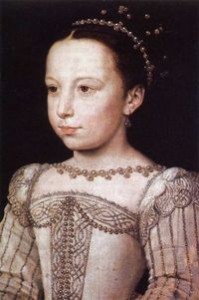
It sprang from the intersection between two strong personal interests. First, I have been fascinated with the Valois royal line since I read Alexandre Dumas’ book La Reine Margot as a teen, and I’ve been particularly obsessed with the oft maligned Marguerite de Valois, youngest daughter of Catherine de Medici and Henri II of France. Second, I have a preoccupation with the relationships that shape women’s lives—especially formative female-to-female relationships. Daughter of de Medici unites those two interests by exploring the sacred, complicated and oh-so-seminal mother-daughter relationship with Marguerite de Valois and Catherine de Medici as main characters.
3. What genre does your book fall under?
Historical fiction. I just can’t imagine writing about the present.
4. Which actors would you choose to play your characters in a movie rendition?
I would cast Keira Knightley to play Marguerite as she has both the beauty (Marguerite was often called the loveliest woman in France) and the depth for the role. If Keira was busy I’d cast Natalie Portman. I’d want Virna Lisi to play Catherine de Medici because she did a breathtaking job in that role in Patrice Chéreau’s 1994 film La Reine Margot.
As for the men in Marguerite’s life, I would cast Benedict Cumberbatch as Henri, Duc de Guise (Marguerite’s first love) or Robert Pattinson if Benny is deemed too old. I’d choose Joseph Gordon-Levitt as Marguerite’s older brother Henri, Duc d’Anjou (future Henri III of France) and Nicholas Hoult as her younger brother François, Duc d’Alençon. I am genuinely stumped on casting Henri de Navarre (Marguerite’s husband and the future Henri IV of France). I am sure the moment I post this I will think of THE perfect casting but for now I’d probably choose Jesse Eisenberg or Anton Yelchin.
5. What is the one-sentence synopsis of your book?
Not really a synopsis—more of a tag line: “Every mother-daughter relationship is fraught with peril. Her mother was Catherine de Medici.” Continue reading Tagged: The Next Big Thing – Find Out What I am Working on Now
Interview with Nancy Bilyeau, Author of The Crown
It is my very great pleasure today to welcome friend and fellow historical fiction writer Nancy Bilyeau to the blog. Nancy’s riveting historical thriller The Crown released in paperback earlier this month. Critically acclaimed since its hardcover debut in January, “O” (The Oprah Magazine) called The Crown, “A juicy blend of lust, murder, conspiracy, and betrayal.” I’ve read it. O is right.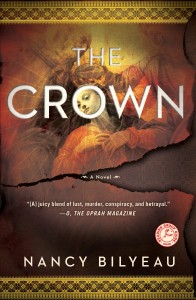
First a blurb to tantalize you: London, May 1537. When Joanna Stafford, a novice nun, learns her cousin is about to be burned at the stake for rebelling against Henry VIII, she makes a decision that will change not only her life but quite possibly, the fate of a nation. Joanna breaks the sacred rule of enclosure and runs away from Dartford Priory to bear witness to her cousin’s execution.
Arrested along with her father at the site of the burning and sent to the Tower of London, Joanna finds herself a pawn in a deadly power struggle. Those closest to the throne are locked in a fierce fight w those desperate to save England’s monasteries from destruction. Charged with a mission to find a hidden relic believed to possess a deadly mystical power, Joanna and a troubled young friar, Brother Edmund, seek answers and clues across England.
And now some questions to take you behind cover-copy (and it’s no exaggeration to say Nancy reveals some things here she has never told readers before):
1) What inspired you to choose a fictional Dominican nun as the heroine of The Crown?
I first chose to set a book in the 16th century—simply because it is my favorite century from history. I love mysteries and thrillers, and wanted to attempt to write one with a female protagonist. It took me a long time to figure out who would be the person. I didn’t want a royal or lady in waiting, yet someone living in a Tudor village, I feared it would be too hard to inject that woman into conflict that rises to the level of a thriller. A nun struggling for her future in the middle of the Dissolution of the Monasteries—when the Catholic Church was being violently dismantled—could be quite compelling. Finally, I picked a Dominican because there was only one such order in England, and that made it special.
2) I found it refreshing that Joanna stayed “in character”—true to the religious sentiments one would expect a 16th century nun to have. How difficult was it for you to achieve that? Do you think it was a risky choice given you are writing for a modern—and generally rather skeptical—audience?
One of my pet peeves is characters in historical novels who have modern sensibilities. It’s the easy way out. There is some strange part of my personality that compels me toward the most difficult choices. Sometimes I wish it were otherwise! But as soon as I decided on a nun, I was determined to make her authentic to the spiritual values of the period. I didn’t want to write a book with a reluctant nun who is forced into it by her father or retreats to a priory after rejection by a man. Again, that’s the easy way out. I did worry that readers would be turned off by a spiritual woman but I’ve not seen that reaction. Readers of historical fiction are eager for authentic behavior, I’m more convinced of that than ever. Commit anachronisms at your peril!
The way I tried to achieve it was reading what women in religious orders actually wrote: Catherine of Siena, Hildegarde of Bingen, Teresa of Avila. That helped get me in the proper mood. Also a writing teacher recommended I research the lives of the early female Catholic saints, the ones who were torn to pieces in the Roman Coliseum or who became martyrs in the Dark Ages and medieval period. The thinking of these women is about as far from a 21st century mindset as you can get. Just fascinating.
3) Your book doesn’t shy away from the unsavory sights or the more malodorous smells of life in Tudor England. In fact, in Joanna’s opening trip to Smithfield the revolting plays a large role. Of course accurate historical details help bring readers to a specific place and time, but I was struck by your very evident emphasis on the unsavory at the beginning of the book. Why specifically did you choose to highlight the grimy side of the 16th century?
I’ve written screenplays and that is a key part of what I like to do: Write visually. It’s not just dialogue and direct character action. I try to do all the research so I can put you on the street, inside the priory cloister, in a barge on the Thames. I wanted to time-travel the reader from the very beginning: You are on your way to Smithfield on execution day in May of 1537, you’re scared and you’re hungry and you’re exhausted—but still resolute. This is what it would feel like, smell like, sound like. Even taste like.
4) Besides Joanna, who is your favorite character in The Crown? Who is your least favorite? Why?
Brother Edmund is my second favorite—I like to think that he is a pretty original character and for some reason I have tremendous sympathy for him. He’s a mix of strengths and weaknesses. I tried my best to make all the characters nuanced. I don’t like two-dimensional people hurtling through thrillers. Or characters with worn-out identifying descriptions: a natural beauty, a strong-jawed man. Ugh.
My least favorite character? Hmmmm. That’s an interesting question. Did I create a character I personally would dislike? Apart from George Boleyn—and I can’t give away why I wouldn’t want to have encountered him at a tender age, or else that would be a spoiler—it would have to be the young prioress. She was inspired by a boss I once had—a very difficult one. In fact, I drew on my personal work history, my years in the magazine business, when depicting life in the priory. I thought about it a lot, and decided that though the stereotype of a nunnery was of graceful, serene ladies floating down the halls in harmony, I imagined that there would be the rivalries and tensions found in any group of people essentially working together, and in this case living together too. I was very happy to receive an email from a Dominican nun and two emails from friars that said I captured correctly the essential feeling of life in an enclosed religious community. 
5) Where have you traveled for inspiration and research for The Crown?
I’ve traveled to most of the places that Sister Joanna Stafford travels to: Dartford, Smithfield, and the Tower of London. Even though the present Tower is closest to what it was in the 1530s, I felt most connected to Joanna in Dartford, in Kent. I walked along the remains of the stone wall that once surrounded the priory of sisters. That is all that remains.
But since I live in New York City, my research trips to England can’t happen as often as I’d like. For inspiration closer to home, I go to the Cloisters Gardens and Museum of the Metropolitan Museum of Art. For anyone who hasn’t had a chance to visit, go! The Cloisters was assembled in the 1930s from a series of medieval French abbeys that they brought over, brick by brick. The re-created rooms are filled with paintings, sculpture, and exquisite objects contemporary to that time. In fact, I got the idea for a murder weapon in The Crown while walking through the Cloisters! I’ve never told any other interviewer that.
6) Truth is often stranger than fiction. During your research for The Crown what was the most unusual or unexpected thing you discovered?
There were certain things I discovered about King Athelstan, the dark ages Saxon monarch, that really surprised me. As much as the Tudor monarchs are over-exposed in some people’s eyes, Athelstan is under-exposed. He arguably was the first king of Britain after he won a enormous battle against the Vikings and the Scots—and no one even knows where the battle was fought. There’s also the question of his sexuality. So interesting.
7) Authors of historical novels walk a line between known historical facts and fiction. Where do you draw the line on your personal map between accuracy and imagination?
My book is not the kind of historical fiction that tells the story, with imagination and new insights, of famous people who once lived. Some “real” people populate The Crown, but most of the characters are from my imagination. And my thriller plot is rather audacious—that’s what folks tell me. So I mixed the carefully researched truth with the fantastical on many pages.
8. Is there anything you’d like to tell us about the Tudor period which even avid readers of Tudor-era fiction might not know—perhaps a preconception you’d like to overturn?
I had no religious or political agenda whatsoever when I started researching this book. But the deeper I got into it, the more I became convinced that the stereotype of a decaying Catholic church that had lost its relevance was wrong. History certainly was written by the winners when it came to the English Reformation. Dartford Priory, where I set most of the book, was a vital center of intellectual achievement and pious observance. Also there was an infirmary in the town run by the priory as well as an almshouse for the poor, and local girls were taught to read there. All that was eliminated when the priory “surrendered” to the will of Henry VIII and the sisters were turned out.
9) Which is most likely to spark the idea for a Nancy Bilyeau novel—a time period, a specific event or a character?
Time period. I am drawn to the time and place, and after that the characters come. Hmmmm. Is that unusual?
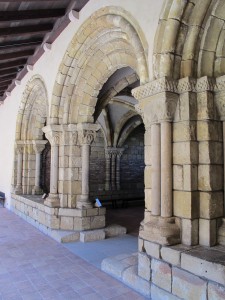
I’d give anything for a lair. I wrote The Crown at the New York Public Library, my kitchen table and various Starbucks. But when I had to write a key scene and needed to get into the mood, I would pack up the laptop and head for The Cloisters. The perfect environment. However, the battery on my laptop would run out in two hours and there are no plugs for writers. Still, I’d take it to the chapter house and sit on the stone “bench” and tap away furiously till the power drained – or the guards started coming after me.
11) If you could read any book again for the first time, what would it be and why?
Rebecca. I read it first when I was in high school and it made a deep and lasting impression on me. I’d like to feel the thrill of some of those revelations again. Since then I’ve re-read it at least six times and come away with a boundless respect for Daphne du Maurier’s craft and also I am so curious about some things in the book. For instance, when Max de Winter tells his second wife that on their honeymoon, Rebecca, laughing, her black hair blowing in the wind, told him things about herself “that I would never repeat to a living soul,” I would love to know—What are those things?
12) I know you are hard at work on the next book in this series, The Chalice, can you share a bit about the new book?
It’s my sequel to The Crown. It’s darker in some ways, with even higher stakes. More executions. And more romance too.
13) In The Crown a Joanna brushes elbows with a number of famous historical characters like Catherine Howard and Stephen Gardiner, Bishop of Winchester, can we expect more cameos from the rich and famous in your sequel? Who might we meet?
Oh I had such a fantastic time researching the “real” people of the time. Gardiner returns, of course; this time Joanna encounters not one but two women who marry Henry VIII. There are a number of aristocrats of the time who played very important parts in history but are not often written about—I put them to work in The Chalice. And finally, Joanna comes face to face with none other than Thomas Cromwell.
About Nancy: Nancy Bilyeau is a writer and magazine editor who has worked on the staffs of InStyle, Rolling Stone, and Ladies’ Home Journal. She is currently the executive editor of DuJour magazine. She was born in Chicago and grew up in Michigan, earning a bachelor’s degree from the University of Michigan. Now she lives in New York City with her husband and two children. The Crown was nominated for an Ellis Peters Historical Dagger Award 2012 by the Crime Writers’ Association, given to Best Historical Crime Novel. Nancy has finished writing a sequel to The Crown, which is called The Chalice.
